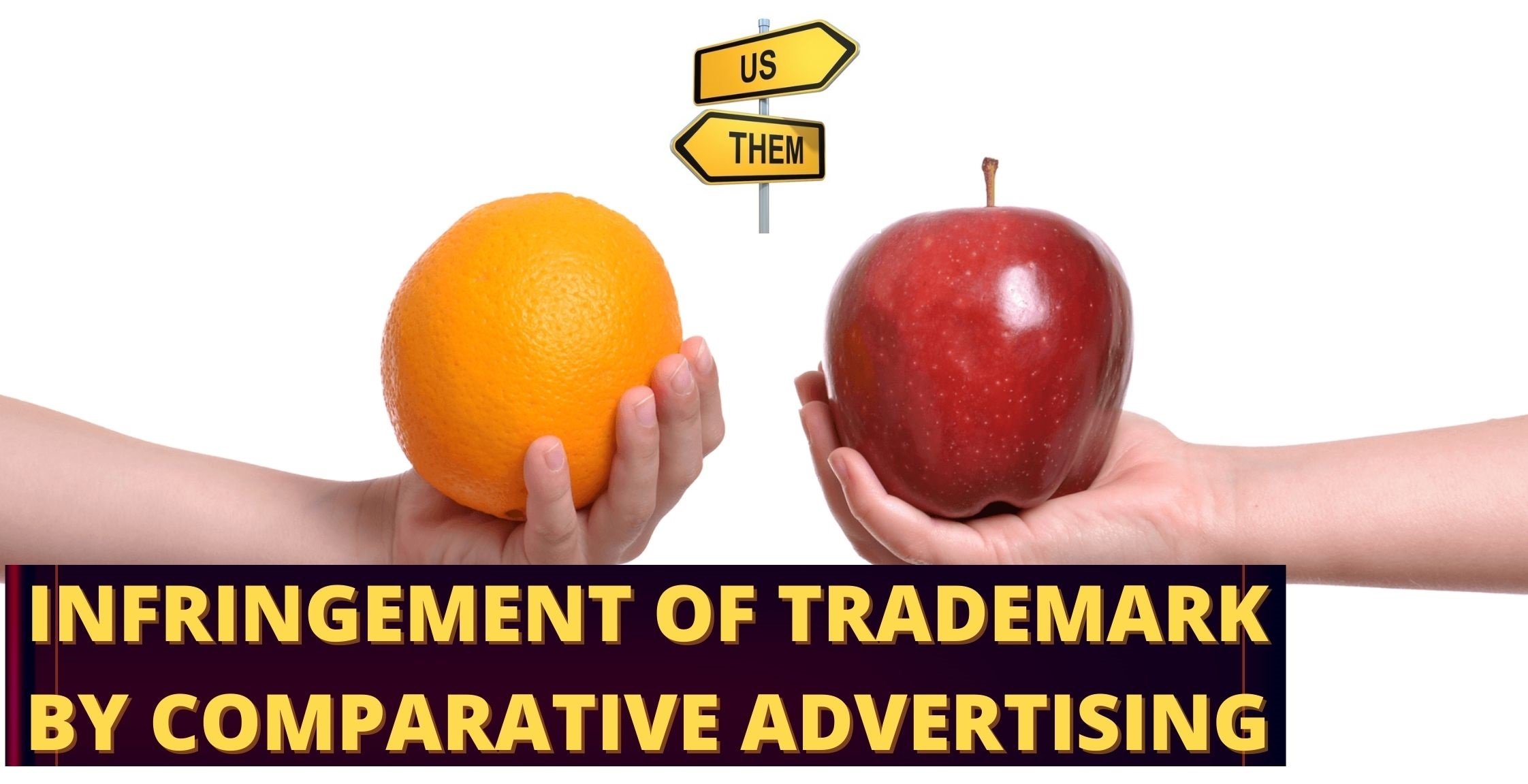AN ANALYSIS OF THE INFRINGEMENT OF TRADEMARK BY COMPARATIVE ADVERTISING
'Comparative advertisement' is the term used to describe advertising where one trader's products or services are contrasted with another trader's goods and services. The consumer profits from the comparative advertisement as it typically contrasts the price, value, quality or other merits of different goods, thus raising a consumer's understanding. However, there is a significant clause added to this: improving the awareness of customers can only be done as long as there is no advertisement of misinformation, which is always a possibility when consumer education is entrusted to institutions with vested interests.

Comparative Advertisement
In many countries, comparative advertising is a widely-used method of commercial advertising. By comparing the characteristics of the advertiser's product with that of the competitor's product, this form of advertisement attempts to influence consumer behaviour. In nature, comparative statements are variable. They can name a competitor directly or refer to him indirectly. They can stress the similarities between the products (positive comparisons) or the differences between them (negative comparisons). They can state that "better than" (superiority claims) or "as good as" the advertised product is the competitor's (equivalence or parity claims). The goal behind this principle is to make an honest (i.e. not misleading) contrast between the factors of the goods of one merchant and those of another; such a comparison would inevitably require the use of the trademarks associated with the goods concerned. Such usage may constitute a trademark infringement in the absence of legislation governing this. "No Indian statute defines the term, but comparative advertising is defined by the UK Regulation as any advertising that "explicitly or indirectly identifies a competitor or products or services provided by a competitor.
'Comparative advertisement' is the term used to describe advertising where one trader's products or services are contrasted with another trader's goods and services. The consumer profits from the comparative advertisement as it typically contrasts the price, value, quality or other merits of different goods, thus raising a consumer's understanding. However, there is a significant clause added to this: improving the awareness of customers can only be done as long as there is no advertisement of misinformation, which is always a possibility when consumer education is entrusted to institutions with vested interests.
Trademark
'Trademark' means a label which is capable of being graphically depicted and which is capable of distinguishing between the products or services of one individual and those of another, including the form of the goods, their packaging and the combination of colours.
'A trademark shall include any word, name, emblem or device, or any combination thereof, which the manufacturer or merchant has approved and used to identify its products and to differentiate them from those created or sold by others. A trademark's primary aim is to 'distinguish one person's products from another. A trademark thus helps a customer to recognise the goods and their sources. Therefore, in the event, if an
In order to make a distinction between its products and that of its rival, an advertiser uses a competitor's trademark and in the process dismisses them, then such an act on the part of the advertiser would not only invoke issues related to comparative advertising and product dismissal but would also invoke issues related to trademark infringement.
What is an infringement of a trademark?
The fundamental problem of trademark infringement is based on customer misunderstanding. Whether one mark is so close to another that an ordinary consumer will likely be confused, mistaken or deceived regarding the source of the goods or service? To decide the matter on the violation, the courts would enquire what is in the mind of the buyer, his reaction to the two marks, and thus whether he is likely to be deceived. Although consumer confusion has been the main concern with respect to trademark infringement in most cases, there are two other causes of confusion that relate to trade rather than to the consumer public: trade confusion and "passing off." In infringement cases, evidence of trade confusion has been deemed quite important because it would not be anticipated that members of the trade would be misled or c. In violation lawsuits, proof of "passing off," where the trader intentionally and purposely seeks to pass one commodity off as another, is often considered important.
Analysis
A trademark's primary aim is to 'distinguish one person's goods from another' Thus, a trademark helps a customer to recognise the products and their sources. Therefore, if an advertiser uses the trademark of a rival to make a distinction between its products and those of its competitor and dismisses them in the process, such an act on the part of the advertiser will not only invoke issues relating to comparative advertising and product dismissal but would also invoke issues relating to infringement of a trademark.
The law on the comparative advertisement and product disparity in relation to trademarks in India is based on the law laid down in Irving's Yeast Vite Ltd v FA Horse-nail. Section 29(8) of the Trademarks Act, 1999 denounces circumstances where infringement may arise from the use of a trademark in advertising. It states that any advertisement which is not compatible with honest standards, or which is harmful to the distinctive character or the prestige of the mark, is an infringement. At the same time, Section 30(1) makes comparative ads an exception to the violation actions referred to in Section 29. It specifies that any advertisement that is compatible with honest standards and does not affect the distinctive character or the prestige of the trademark is acceptable and does not constitute an infringement.
The Law on Trademark Infringement and Comparative Advertisement
The law on ‘comparative advertising and use of a competitor’s trademark could be summarized as:
- Enabling comparative ads is the primary purpose of Section 29(8) and Section 30(1) of the Trademarks Act, 1999.
- As long as the use of a competitor's mark is truthful, there is no error in stating the merits of competing products or services and in defining them by using registered trademarks.
- It is the duty of the licensed proprietor to demonstrate that the factors referred to in the section's proviso are relevant.
- No infringement can occur unless the use of the label is not compatible with honest practices.
- The test is objective: upon receiving the advertisement, a fair reader will be inclined to conclude that it is truthful.
- The codes of conduct agreed by the law or industry are not appropriate guidelines as to whether a practice is honest for the purposes of Section 29(8) and Section 30
- The honesty of the advertising for the products or services in use must be treated as fair to the relevant public.
- It should be held in mind that these types of advertisement are used by the general public.
- The Act would not place a duty on the courts to try to implement a more puritanical norm by legislation than the general public would expect from an advertisement.
- An advertising which is substantially deceptive for the purposes of Section 29(8) and Section 30(1) is not truthful.
- It is important to view the commercial as a whole.
- If the context of advertising, as a whole, justifies the definition, it should be acceptable even if it is misleading for interlocutory purposes.
Section 30(1) of the Trademark Act, 1999 requires comparative advertising, which reads as follows: Nothing in section 29 shall prohibit any person from using a registered trademark for the purpose of identifying products or services as being used by the proprietor:
(a) be consistent with honest standards in industrial or commercial matters, and
(b) is not intended to take undue advantage of the distinctive character or prestige of the label or to be harmful to it.
But with certain limitations established by u/s 29(8) which reads as follows: any advertisement of that trademark is infringed by a registered trademark if such advertising:—
(a) takes undue advantage of honest practices in industrial or commercial matters and is contrary to them; or
(b) is harmful to its distinctive character, or
(c) is harmful to its distinctive character; or
(d) is against the trademark's reputation.
Section 36A of the MRTP Act lists a range of "unfair trade practices" acts. Section 36A(1)(x) includes a clause relating to the comparative representation, which reads as follows:
36A. Definition of unfair commercial practice: 'unfair commercial practice' means a commercial practice which adopts any unfair or unfair or deceptive practice, including any of the following practices, for the purpose of promoting the sale, use or supply of any products, or for the purpose of providing any service, namely:
(1) the practice of making any declaration, either orally or in writing, or by visible representation, which -
(x) offers incorrect or misleading information that misrepresents another person's products, services or trade.
The defense provided for in the Trademark Act of 1999 applies to a registered trademark. References to well established unregistered marks are often protected by the Trademarks Act. This offers the proprietor a statutory option of handing off the common law action.
TO KNOW MORE ABOUT ADVERTISING ETHICS, WATCH THIS VIDEO -
BY - RAKSHA SINGHAL












